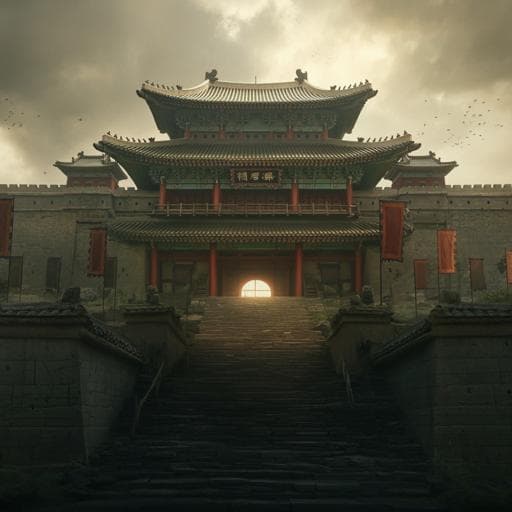
Humanities
Japan's construction of defensive fortifications and its implications for East Asian relations during the Tang dynasty
Z. Li and K. Liu
Discover the intriguing history of Japan's defensive fortifications during the Tang Dynasty with research by Zhuang Li and Kehua Liu. This study uncovers the potential early construction of Onojo, challenging established timelines and exploring Japan's evolving geopolitical strategies in East Asia.
~3 min • Beginner • English
Introduction
The study addresses how Japan perceived and responded to foreign relations in East Asia during the 7th–9th centuries, a topic often overshadowed by analyses focused on Silla, Baekje, and Goguryeo or on the Tang dynasty’s actions. Prior research has examined later 7th-century dynamics and post-Baekgang relations, but has rarely explored Japan’s view in the first half of the 7th century. This paper fills that gap by assessing the timing, rationale, and development of Japanese defensive fortifications—especially Itōjō and Ōnojo—to illuminate changes in Japan’s perception of external threats, arguing that Japan’s sense of external tension predated the Battle of Baekgang and that fortification building likely began by ca. AD 650. The work situates fortification activity within broader geopolitical shifts, including Silla–Tang rapprochement, Tang expansion, and Japan’s evolving diplomatic strategies, while also considering domestic political reforms and centralization.
Literature Review
Scholarship on East Asian international relations in the 7th–9th centuries largely centers on conflicts among Silla, Baekje, and Goguryeo and Tang’s role (Owada 2012; No 2012; Shen 1994). Suzuki (2011) examined late 7th-century tensions amid Tang expansion; Chen (2012) analyzed Tang–Japan relations from Baekgang to the early 8th century. Kitou (1976) traced regional relations from the 630s–670s as shaped by Tang foreign policy. Studies of envoys and cultural exchange (Kimiya 1955; Fujie 1977; Ge 2007) show route shifts and diplomatic interplay. Fortification scholarship examines siting and construction of ancient mountain fortresses (Takahashi 1972), techniques and artifacts (Historical PKC 2016), and links to domestic governance (Kuramoto 2010; Suzuki 2011; Yamazaki 2018; Ehime PHCC 1984). Zhao (2015) synthesized post-Baekgang defensive systems. Despite this body of work, few studies explicitly analyze how Japan’s fortification programs reflect its changing relations with Tang China and neighbors across the 7th–8th centuries, particularly in the early 7th century. This study integrates textual, diplomatic, and archaeological findings to address that gap.
Methodology
The paper conducts a historical-analytical study combining primary textual sources with archaeological and environmental evidence. Key sources include Nihongi, Shoku Nihongi, Jiutangshu, Xintangshu, Zizhitongjian, Wujingzongyao, Zenrinkokuhouki, and other chronicles documenting envoy movements, battles, and state edicts. It synthesizes site-based data on ancient mountain fortresses from educational boards and site reports (e.g., Takamatsu City Education Committee; Historical Park Kikuchi Castle Onkosouseikan 2019) and details such as Muzuki’s dimensions and associated waterworks. The study cites dendrochronological findings from Sugihara (2017) on Sciadopitys verticillata timber from Ōnojo to estimate construction timing around AD 650. It also compiles chronological and locational data for fortresses (Table 1) and interprets diplomatic episodes (e.g., envoy numbers, ship counts, anchorage decisions) to contextualize military preparations and threat perceptions. The approach is interpretive, triangulating multiple records to infer timelines, strategic objectives, and geopolitical implications.
Key Findings
- Post-Baekgang fortification wave and coastal defense network: Following the AD 663 defeat, Japan rapidly established guards and beacons on Tsushima and Iki and constructed Muzuki (AD 664), Ōnojo and Kiijo (AD 665), and later Kanetajo, Yashimajo, and Takayasujo (AD 667), forming a defensive system centered on Dazaifu and extending through northern Kyushu, the Seto Inland Sea, and Kinai. Many sites were coastal or riverine, reflecting maritime threat focus.
- Muzuki’s scale and function: Muzuki (Dazaifu, Fukuoka) is a large embankment ~1.2 km long, ~80 m wide at base, and >13 m high, with a 60 m wide, 4 m deep reservoir on the Hakata side, interpreted as downstream water storage and a defensive-waterwork complex protecting Dazaifu.
- Diplomatic-military interplay after Baekgang: Tang–Silla used coordinated land-naval operations; Tang fleets employed Mengchong and Louchuan warships. Japan, shocked by Tang naval superiority, pivoted to defense and centralization. Diplomatic episodes include a fleet of 47 ships carrying 2,000 persons (600 Tang envoys plus 1,400 escorts/prisoners) anchoring at Hichi Island to avoid alarm; equal-status exchanges are implied by communications between Ungjin Commandery and Tsukushi Governorate. Japan at times rebuffed Tang overtures while prioritizing fortifications.
- Itojō’s construction and geopolitical drivers: Itōjō (construction initiated AD 756, completed AD 768) was overseen by Kibi no Makibi, a learned envoy in Tang. It was built amid the An–Shi Rebellion (AD 755–763) and in the context of Japan–Balhae cooperation against Silla as Tang’s support for Silla wavered. Japan ordered extensive shipbuilding—500 ships total (Hokurikudō 89; Sanindō 154; Sanyōdō 161; Nankaidō 105)—anticipating conflict; Balhae remained cautious. Although the campaign against Silla did not materialize, Itōjō exemplified defensive prioritization during regional instability.
- Reassessment of Ōnojo’s date: While Nihongi records completion in AD 665, comparative construction durations with Itōjō and dendrochronology (Sugihara 2017) suggest Ōnojo’s construction may have begun circa AD 650, predating Baekgang. This indicates Japan sensed external tensions earlier, coinciding with Silla–Tang rapprochement (e.g., Silla adoption of Tang dress and norms) and emerging Japanese hostility toward Silla.
- Stylistic evolution of fortifications: Ōnojo, built by Baekje craftsmen, is characterized as a Joseon-style mountain castle; a century later, Itōjō reflects Chinese-style techniques likely informed by Kibi no Makibi’s Tang learnings. This stylistic shift mirrors intensifying Sino–Japanese cultural and technical exchange between the late 7th and mid-8th centuries.
- Long-run pattern of coastal and mountain fortifications: Japan repeatedly concentrated defenses along coasts and rivers: after Baekgang (7th c.), during Silla pirate threats (9th c., ordering coastal defenses), in the Mongol invasions (1274, 1281) with a 20 km stone defense around Hakata Bay up to 3 m high, and during Hideyoshi’s invasions (1592–1598) with numerous Wajō along Korea’s southern coast. Site selection consistently emphasized littoral and mountainous terrain.
Key data points: Muzuki dimensions (~1.2 km length, 80 m base width, >13 m height; ditch 60 m x 4 m); ship counts (Tang envoy fleet 47 ships; Japan shipbuilding total 500); envoy counts (600 Tang envoys + 1,400 escorts/prisoners).
Discussion
The findings address the research question by showing that Japanese fortification programs were both indicators and instruments of Japan’s evolving foreign relations in the Tang era. Evidence suggests that, rather than arising solely from the shock of Baekgang, Japan initiated large-scale defensive preparations by ca. AD 650 in response to Silla’s alignment with Tang and associated shifts in regional power. The creation of a fortified ring around Dazaifu and rapid deployment of beacon networks reflect a strategic reorientation toward deterrence and readiness against maritime threats. Fortifications also intersected with domestic centralization efforts during and after the Taika reforms, serving to consolidate authority and mobilize regional resources. Itōjō’s construction during the An–Shi Rebellion reveals Japan’s sensitivity to pan-East Asian instability and willingness to coordinate with Balhae against Silla, even as direct campaigns were not executed. Stylistic changes from Joseon- to Chinese-influenced fortress design illustrate the depth of Sino–Japanese exchanges in the intervening century. Overall, the fortification chronology elucidates Japan’s shifting diplomatic posture—from tentative engagement, through defensive consolidation, to selective alignment—as it navigated Tang hegemony and peninsular dynamics.
Conclusion
The study argues that Ōnojo’s construction likely began around AD 650, predating the Battle of Baekgang, thereby revising the conventional chronology that ties Japanese fortification efforts primarily to post-Baekgang anxieties. This reinterpretation aligns with contemporaneous Silla–Tang rapprochement and Japan’s increasingly wary stance toward Silla, suggesting that Japan perceived external threats earlier and responded proactively. By situating Itōjō’s decade-long construction amid the An–Shi Rebellion and Japan–Balhae interactions, the paper shows how fortifications both mirrored and influenced Japan’s diplomatic strategies. Extending beyond the Tang period, Japan’s persistent emphasis on coastal and mountain fortifications—from Muzuki and Ōnojo to Mongol-invasion defenses and Wajō in Korea—demonstrates a durable defensive logic that shaped regional relations across centuries. Future research could refine fortress chronologies through expanded archaeological investigations (e.g., dendrochronology, materials analysis), integrate GIS-based spatial modeling of defense networks, and more deeply examine administrative-military linkages between fortification programs and Ritsuryō governance.
Limitations
The paper relies primarily on historical chronicles and archaeological syntheses, which can be fragmentary and interpretive. Some diplomatic episodes lack detailed records of discussions or outcomes, limiting certainty about causal linkages. Proposed early dating of Ōnojo (ca. AD 650) draws in part on dendrochronological evidence that the authors note as requiring confirmation. Interpretations distinguishing external versus internal drivers acknowledge that prior arguments about domestic motives (e.g., centralization, suppression of local clans) are often hypothetical; this study prioritizes external factors, which may understate complex domestic influences.
Related Publications
Explore these studies to deepen your understanding of the subject.







